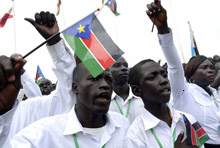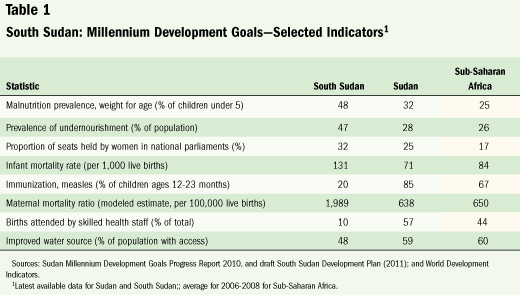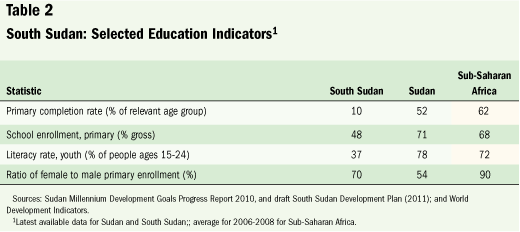
Typical street scene in Santa Ana, El Salvador. (Photo: iStock)
IMF Survey: South Sudan Faces Hurdles as World's Newest Country
July 18, 2011
- Newfound independence gives hope to South Sudanese
- Country faces challenges in human capital, infrastructure
- IMF is helping build South Sudan’s capacity for macroeconomic management
Since the Comprehensive Peace Agreement in 2005, South Sudan has set out to build an economy almost from scratch, creating economic institutions and working toward establishing an environment conducive to growth and stability.

South Sudanese celebrate: Achieving independence was an important step, but the new country has a long road ahead of it (photo: Spiekermeier/SIPA/Newscom)
NORTH AFRICA
After decades at war, South Sudan faces considerable difficulties. With a population of about 8 million, the country covers a land area nearly as large as France, but has only 100 kilometers of paved roads. One of least developed nations in the world, South Sudan lags the rest of sub-Saharan Africa on most of the U.N.’s Millennium Development Goals, with half its population living below the poverty line (see Table 1).
“South Sudan’s challenges are formidable,” says Kristina Kostial, the IMF’s mission chief for the country. “Much has been done since 2005, and achieving independence on July 9 was a very important step, but the South Sudanese still have a long road ahead of them.”
The new country has untapped potential, Kostial says. There are large livestock, fishery, and forestry resources, which—together with adequate rainfall, fertile land, and available water—could hold promise for labor-intensive agricultural exports. Developing agriculture in South Sudan could reduce the country’s dependence on oil, which currently accounts for 98 percent of the government’s revenue. And revenue from oil provides an opportunity to invest in social and infrastructure development and set aside savings for the future.

New beginning
Sudan’s civil conflict went on for nearly 50 years with few breaks, starting just before independence from Egypt and the United Kingdom in 1956 and ending in 2005 with the signing of the peace agreement.
The agreement provided for a six-year interim period of autonomy for South Sudan, followed by a referendum for the people of South Sudan to determine their future status. In January 2011, the South Sudanese voted overwhelmingly in favor of secession. Since then, leaders from both sides—with help from the African Union—have been negotiating the terms of the secession.
Several factors complicate Sudan’s split, but the most contentious is the division of oil resources. While the majority of the oil fields are found in the south, the oil pipelines flow north to Port Sudan on the Red Sea. Cooperation between the two countries will be essential.
Three key issues are at the heart of the negotiations taking place under the auspices of the African Union:
• Oil sharing. The 50-50 split of oil revenues was scheduled to end at independence, but how future oil revenues will be divided remains open. South Sudan is expected to pay Sudan a transit fee for the use of its pipeline, but the amount of the fee has not yet been established, nor is it clear how much revenue sharing will take place.
• Debt. There is tentative agreement that Sudan would take over all debt on the condition that creditors commit to debt relief within two years in the context of the IMF and World Bank’s Heavily Indebted Poor Country (HIPC) Initiative and that South Sudan help lobby in support of Sudan. Should this fail, debt would be apportioned based on a formula that has yet to be determined.
• Currency. The parties have not yet agreed on what will happen with the Sudanese pounds that are currently circulating in the South. South Sudan introduced a new currency on July 12 and Sudan is also expected to introduce its own new currency.
Beyond these issues for short-term resolution, South Sudan faces other, more long-term problems. Human capital levels are extraordinarily low. At 37 percent, the youth literacy rate is half the sub-Saharan Africa average (see Table 2). About half of the children enroll in primary school, yet only 10 percent complete it. With one-third of South Sudan’s population under the age of 10, boosting educational levels is vital to the country’s development.

Another difficulty is the lack of basic infrastructure. In addition to the dearth of paved roads outside Juba, the capital, there is no airport that meets international civil aviation standards, and river channels have not yet been made navigable. Progress is being made on increasing electricity generation capacity, but blackouts are frequent and businesses make much use of generators.
Economic Implications for the North
The independence of South Sudan could have a significant impact on the Sudanese economy. Sudan may lose some 75 percent of its oil revenues, which could translate into domestic and external imbalances. With oil revenue constituting more than half of government revenue and 90 percent of exports, the economy will need to adjust to a permanent shock, particularly at a time when the country has little access to external financing. The size and nature of the necessary adjustment could have significant implications for growth and macroeconomic stability.
Sudan will likely have to exercise fiscal restraint by streamlining nonpriority spending, reducing fuel subsidies, reducing tax exemptions, and enhancing revenue administration. Continuing to allow greater exchange rate flexibility, tightening monetary policy, and implementing structural reforms in a timely manner will also be crucial.
A third issue relates to the production of oil. The volume of oil produced in South Sudan’s oil fields is peaking now, which means that this key source of export revenue will decline over time. With technology improvements, oil extraction in the existing fields could be made more efficient, and new sources of oil might be discovered. But these are both long-term propositions, Kostial stressed, so the government is looking at ways of developing new, nonoil sources of revenue.
There is also a need to ensure that resources are being used effectively through transparent and effective budget processes, Kostial said. Resolving these issues—together with a robust legal framework and strengthened financial sector—will enable the private sector to become an engine of growth for the economy.
Building capacity
South Sudan has approached the IMF for technical assistance in building the capacity and institutions to manage its nascent economy. This is particularly important for assisting the Bank of South Sudan to become a full-fledged central bank. The IMF stands ready to provide technical assistance in its areas of core expertise to enable the design, implementation and monitoring of sound macroeconomic policies, including by developing a fiscal framework, establishing the central bank and its core activities, building statistical capacity, and putting in place the legislative framework required for effective economic and financial management.
To fund this assistance, the IMF intends to seek donor contributions to a special trust fund for IMF capacity building in South Sudan. The trust fund would total $10.6 million for a period of just under four years.
IMF membership
South Sudan applied for IMF membership on April 15, but the process will take time. Under the IMF’s prescribed procedures for membership applications, South Sudan’s application must first be examined by the IMF’s Executive Board. Following this examination, the Executive Board submits a report to the Board of Governors of the IMF with recommendations in the form of a membership resolution. These recommendations cover the amount of quota in the IMF, the form of payment of the subscription, and other customary terms and conditions of membership.
After the Board of Governors has adopted the membership resolution, the applicant country may become a member once it has taken the legal steps required under its law to enable it to sign the IMF's Articles of Agreement and to fulfill the obligations of IMF membership.
The IMF currently has 187 member countries.


